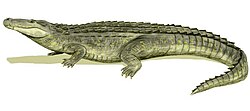| Orthogenysuchus Temporal range: Early Eocene | |
|---|---|
| Scientific classification | |
| Kingdom: | Animalia |
| Phylum: | Chordata |
| Class: | Reptilia |
| Clade: | Archosauria |
| Order: | Crocodilia |
| Family: | Alligatoridae |
| Subfamily: | Caimaninae |
| Genus: | † Orthogenysuchus Mook, 1924 |
| Type species | |
| †Orthogenysuchus olseni Mook, 1924 | |
Orthogenysuchus is an extinct genus of caimanine alligatorids. Fossils have been found from the Wasatch Beds of the Willwood Formation of Wyoming, deposited during the early Eocene. The type species is O. olseni. The holotype, known as AMNH 5178, is the only known specimen belonging to the genus and consists of a skull lacking the lower jaws. The braincase is filled in by the matrix and most of the suture lines between bones are indiscernible, making comparisons with other eusuchian material difficult. [1]


